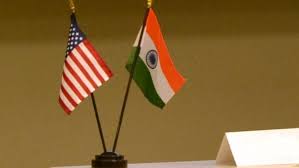
United States Secretary of Defence Lloyd Austin, on his second visit to India, held high-level talks with Defence Minister Rajnath Singh on Monday, echoing the shared concerns of both nations regarding geopolitical pressures from China and Russia. During a press conference following the bilateral meeting, Austin underscored China’s increasing efforts to “redraw borders by force” and Russian aggression towards Ukraine, characterising these actions as a threat to national sovereignty and global peace.
Austin hailed the Indo-US partnership as the cornerstone of a free and open Indo-Pacific, highlighting the importance of democracies rallying around shared values to protect and preserve peace and prosperity. In the face of current challenges such as transnational terrorism and climate change, he emphasised the significance of vigorous leadership from both the United States and India.
The Defence Secretary praised the growth of the India-US global strategic partnership, terming it critical for maintaining a free, open and rules-bound Indo-Pacific region. Austin’s visit focused on furthering this partnership through discussions on a series of key initiatives, including the INDUS-X, aimed at fostering collaboration between the US and Indian defence innovation sectors.
Furthermore, a roadmap for Defence Industrial Cooperation was concluded during Austin’s visit. This roadmap outlines opportunities for co-development of new technologies, co-production of existing and new systems, and increased collaboration between defence start-up ecosystems in both nations.
Austin, fresh from his speech at the Shangri-La Security Summit in Singapore, reiterated his warnings about the potential devastation from conflict in the Taiwan Strait and criticised China’s disruptive actions in the region. The security of commercial shipping lanes, global supply chains, and freedom of navigation worldwide, he said, hinges on maintaining peace and stability in the Taiwan Strait.
During the press conference, Austin also addressed the ongoing Russian-Ukraine conflict, alluding to Russia’s construction of defences along the occupied territory’s border. He argued that despite Russia’s fortifications, the defence systems could not cover all areas, thus providing opportunities for the Ukrainians to exploit.
While enhancing defence cooperation in areas including convergence of strategic interests and enhanced security cooperation, both leaders welcomed the inaugural talks held recently focusing on defence artificial intelligence and defence space.
They agreed to maintain the momentum of the “robust and multifaceted” bilateral defence cooperation activities, with Rajnath Singh echoing these sentiments in a tweet following the meeting.
Austin’s visit concluded with a Tri-Services Guard of Honour in his presence at the Manekshaw Centre in Delhi, symbolising the deepening bonds between the two nations. As the world’s two largest democracies, India and the United States’ growing military cooperation is set to become a force for global good, preserving a rules-based international order in the face of geopolitical threats.
Austin underlined the significant strides the two countries have taken towards strengthening their defence partnership. He shed light on the establishment of an ambitious new roadmap for defence industrial cooperation, aimed at fast-tracking high priority co-development and co-production projects, and fostering closer ties between their defence industries. This roadmap is set to play a critical role in the years to come, providing a clear path for collaboration between the two nations.
One of the key outcomes of Austin’s visit was the discussion of the INDUS-X initiative, an ambitious project designed to jumpstart partnerships between the US and Indian defence innovation sectors. This new initiative is seen as a significant step forward in defence collaboration between the two nations and will be formally launched during Prime Minister Modi’s upcoming state visit to Washington.
Austin expressed optimism about the growing pace and scope of joint military exercises between India and the US. He noted that some of America’s most advanced and strategic aircraft, such as the F35 and B1 bombers, had recently participated for the first time in the annual Cope India Air Exercises. These exercises have been instrumental in increasing cooperation and information sharing between the two countries, setting the stage for future initiatives to improve maritime cooperation, including in the undersea domain.
While expressing gratitude for the warm reception he received during his visit, Austin took to Twitter to thank Rajnath Singh for his unwavering commitment to US-India defence relations.
He praised Singh’s leadership in paving the way for deeper collaboration, joint exercises, and technology sharing between the two countries.
As the geopolitical landscape evolves, the deepening partnership between the US and India, reinforced by Austin’s recent visit, is seen as critical to maintaining regional stability. Their unified stance against threats to national sovereignty and the rules-based international order promises to secure a more peaceful and prosperous future for the Indo-Pacific and the wider world.